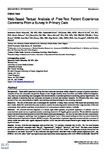Web-Based Textual Analysis of Free-Text Patient Experience Comments From a Survey in Primary Care
| dc.contributor.author | Maramba, Inocencio Daniel | |
| dc.contributor.author | Davey, A | |
| dc.contributor.author | Elliott, MN | |
| dc.contributor.author | Roberts, Martin | |
| dc.contributor.author | Roland, M | |
| dc.contributor.author | Brown, F | |
| dc.contributor.author | Burt, J | |
| dc.contributor.author | Boiko, O | |
| dc.contributor.author | Campbell, J | |
| dc.date.accessioned | 2015-10-20T20:37:59Z | |
| dc.date.available | 2015-10-20T20:37:59Z | |
| dc.date.issued | 2015-05-06 | |
| dc.identifier.issn | 2291-9694 | |
| dc.identifier.issn | 2291-9694 | |
| dc.identifier.uri | http://hdl.handle.net/10026.1/3666 | |
| dc.description.abstract |
BACKGROUND: Open-ended questions eliciting free-text comments have been widely adopted in surveys of patient experience. Analysis of free text comments can provide deeper or new insight, identify areas for action, and initiate further investigation. Also, they may be a promising way to progress from documentation of patient experience to achieving quality improvement. The usual methods of analyzing free-text comments are known to be time and resource intensive. To efficiently deal with a large amount of free-text, new methods of rapidly summarizing and characterizing the text are being explored. OBJECTIVE: The aim of this study was to investigate the feasibility of using freely available Web-based text processing tools (text clouds, distinctive word extraction, key words in context) for extracting useful information from large amounts of free-text commentary about patient experience, as an alternative to more resource intensive analytic methods. METHODS: We collected free-text responses to a broad, open-ended question on patients' experience of primary care in a cross-sectional postal survey of patients recently consulting doctors in 25 English general practices. We encoded the responses to text files which were then uploaded to three Web-based textual processing tools. The tools we used were two text cloud creators: TagCrowd for unigrams, and Many Eyes for bigrams; and Voyant Tools, a Web-based reading tool that can extract distinctive words and perform Keyword in Context (KWIC) analysis. The association of patients' experience scores with the occurrence of certain words was tested with logistic regression analysis. KWIC analysis was also performed to gain insight into the use of a significant word. RESULTS: In total, 3426 free-text responses were received from 7721 patients (comment rate: 44.4%). The five most frequent words in the patients' comments were "doctor", "appointment", "surgery", "practice", and "time". The three most frequent two-word combinations were "reception staff", "excellent service", and "two weeks". The regression analysis showed that the occurrence of the word "excellent" in the comments was significantly associated with a better patient experience (OR=1.96, 95%CI=1.63-2.34), while "rude" was significantly associated with a worse experience (OR=0.53, 95%CI=0.46-0.60). The KWIC results revealed that 49 of the 78 (63%) occurrences of the word "rude" in the comments were related to receptionists and 17(22%) were related to doctors. CONCLUSIONS: Web-based text processing tools can extract useful information from free-text comments and the output may serve as a springboard for further investigation. Text clouds, distinctive words extraction and KWIC analysis show promise in quick evaluation of unstructured patient feedback. The results are easily understandable, but may require further probing such as KWIC analysis to establish the context. Future research should explore whether more sophisticated methods of textual analysis (eg, sentiment analysis, natural language processing) could add additional levels of understanding. | |
| dc.format.extent | e20-e20 | |
| dc.format.medium | Electronic | |
| dc.language | en | |
| dc.language.iso | eng | |
| dc.publisher | JMIR Publications Inc. | |
| dc.subject | free-text comments | |
| dc.subject | patient experience | |
| dc.subject | patient feedback | |
| dc.subject | quantitative content analysis | |
| dc.subject | textual analysis | |
| dc.title | Web-Based Textual Analysis of Free-Text Patient Experience Comments From a Survey in Primary Care | |
| dc.type | journal-article | |
| dc.type | Journal Article | |
| plymouth.author-url | https://www.ncbi.nlm.nih.gov/pubmed/25947632 | |
| plymouth.issue | 2 | |
| plymouth.volume | 3 | |
| plymouth.publication-status | Published online | |
| plymouth.journal | JMIR Medical Informatics | |
| dc.identifier.doi | 10.2196/medinform.3783 | |
| plymouth.organisational-group | /Plymouth | |
| plymouth.organisational-group | /Plymouth/Faculty of Health | |
| plymouth.organisational-group | /Plymouth/Faculty of Health/Peninsula Medical School | |
| plymouth.organisational-group | /Plymouth/REF 2021 Researchers by UoA | |
| plymouth.organisational-group | /Plymouth/REF 2021 Researchers by UoA/UoA23 Education | |
| plymouth.organisational-group | /Plymouth/Research Groups | |
| plymouth.organisational-group | /Plymouth/Research Groups/Institute of Health and Community | |
| plymouth.organisational-group | /Plymouth/Users by role | |
| plymouth.organisational-group | /Plymouth/Users by role/Academics | |
| dc.publisher.place | Canada | |
| dcterms.dateAccepted | 2014-12-20 | |
| dc.identifier.eissn | 2291-9694 | |
| dc.rights.embargoperiod | No embargo | |
| rioxxterms.versionofrecord | 10.2196/medinform.3783 | |
| rioxxterms.licenseref.uri | http://www.rioxx.net/licenses/all-rights-reserved | |
| rioxxterms.licenseref.startdate | 2015-05-06 | |
| rioxxterms.type | Journal Article/Review |


